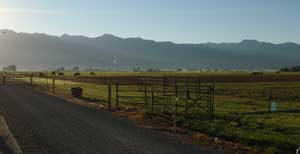Environment
Effects of Environment on Plant Secondary Compounds
 Plants naturally produce primary and secondary compounds. Primary compounds are used for growth and development, and until recently secondary compounds (SCs) were thought of as metabolic waste products rendering foods and forages unpalatable for humans and other animals. However, research of the past 40 years has revealed endless benefits of SCs to soil, plants, and animals including humans.
Plants naturally produce primary and secondary compounds. Primary compounds are used for growth and development, and until recently secondary compounds (SCs) were thought of as metabolic waste products rendering foods and forages unpalatable for humans and other animals. However, research of the past 40 years has revealed endless benefits of SCs to soil, plants, and animals including humans.
All plants contain SCs and many of these compounds are thought to set a limit on intake for herbivores especially when offered as monocultures. However, in small doses these compounds may offer health benefits for humans and other animals. For instance, resveratrol a polyphenolic compound present in grapes, wine, soya, and peanuts helps prevent heart disease and various types of cancer in humans. Condensed tannins reduce internal parasites in ruminants, and enhance the absorption of amino acids in the small intestine.
Herbivores eat more and perform better when offered a variety of plants that vary in concentrations of different nutrients and secondary compounds. When plants are grown in monocultures, especially those bred to be low in SC, large amounts of fertilizer, herbicides and pesticides are needed to maintain the stand. Plants often benefit from growing in mixtures and reduce the need for the inputs listed above.
We know very little about how various grazing practices, agricultural methods, and mixtures of plants may affect concentrations of SCs. The dynamics between herbivory, above and below the soil surface, and the environment is an integral part of nature's circle of life. However, the research and views of how grazing impacts the environment are incredibly diverse.
 USU graduate student, Andrea Clemensen, is interested in some agronomic as well as environmental factors that may affect concentration of certain SCs. She is investigating how different management practices (animal impact vs. chemical inputs) affect soil quality, nutrient cycling, and SC concentration, in addition to investigating how plant diversity (monocultures vs. two-way mixtures) affects primary and SCs in plants, as well as soil characteristics. Her research involves tall fescue, (Festuca arundinacea), reed canarygrass (Phalaris arundinacea), alfalfa (Medicago sativa),and tannin containing sainfoin and birdsfoot trefoil (Lotus corniculatus).
USU graduate student, Andrea Clemensen, is interested in some agronomic as well as environmental factors that may affect concentration of certain SCs. She is investigating how different management practices (animal impact vs. chemical inputs) affect soil quality, nutrient cycling, and SC concentration, in addition to investigating how plant diversity (monocultures vs. two-way mixtures) affects primary and SCs in plants, as well as soil characteristics. Her research involves tall fescue, (Festuca arundinacea), reed canarygrass (Phalaris arundinacea), alfalfa (Medicago sativa),and tannin containing sainfoin and birdsfoot trefoil (Lotus corniculatus).
Alfalfa contains saponins and birdsfoot trefoil contains tannins. Both plants fix nitrogen improving pasture growth and the crude protein content of forage. Endophyte-infected tall fescue produces two types of alkaloids, those associated with the plant and those due to a fungus that lives in the grass. Reed canarygrass contains eight alkaloids. These secondary compounds benefit the plant by reducing the need for pesticides and herbicides.
Trefoil samples were analyzed for condensed tannins, fescue samples for the alkaloid ergovaline, reed canarygrass samples for the alkaloid gramine, and alfalfa for saponins. Andrea also investigated how plants respond to nutrient inputs from animals by applying commercial fertilizer, green manure and fecal manure to each of these forage species growing in monoculture.
Concentrations of secondary compounds varied during the growing season. Saponins in alfalfa ranged between 0.8% and 5%. Tannins in birdsfoot trefoil ranged between 0.8% and 8%. Saponins and tannins were lowest in May and highest in July. Alkaloids (ergovaline) in tall fescue ranged between 60 to 350 ppb with the lowest concentrations in May and the highest in August. Concentrations of saponins or tannins in the legumes did not change when grown next to tall fescue. However, tall fescue growing near legumes had much higher concentrations of ergovaline (350 ppb) and crude protein (9%) than tall fescue growing in monoculture (ergovaline (137 ppb) and crude protein (6%).
More results to come.

